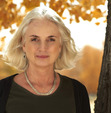Julene Bair's Blog, page 7
January 8, 2018
Our Turn at this Earth: In the Mojave’s Mirror
“Our Turn at this Earth” airs every Thursday at 6:44 pm CT on KANZ (High Plains Public Radio).
http://www.julenebair.com/wp-content/uploads/2018/01/05541_regional_In-the-Mojaves-Mirror-airs-010418.mp3
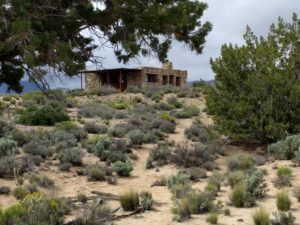 As a young woman, newly single after my marriage had ended, I bought a little one-bedroom Victorian in an unassuming, foggy San Francisco neighborhood. That house would be worth a fortune today. But I was young then. I didn’t think about my financial security in the distant future. I wanted to live my dream now. I sold the house a few years after I bought it for what I considered a tidy profit and moved to the Mojave Desert, to live alone in a rock cabin and teach myself to write. The money, I figured, would carry me for about two years, after which I could support myself selling stories to magazines.
As a young woman, newly single after my marriage had ended, I bought a little one-bedroom Victorian in an unassuming, foggy San Francisco neighborhood. That house would be worth a fortune today. But I was young then. I didn’t think about my financial security in the distant future. I wanted to live my dream now. I sold the house a few years after I bought it for what I considered a tidy profit and moved to the Mojave Desert, to live alone in a rock cabin and teach myself to write. The money, I figured, would carry me for about two years, after which I could support myself selling stories to magazines.
At the time, it didn’t occur to me to draw parallels between the desert’s aridity and the steppes of the High Plains, where I’d been raised. I just knew that I craved the desert’s panoramic vistas and felt that, somehow, I would be my most authentic self there.
It takes a long time to learn to write well. As it turned out, all that my literary efforts yielded were enough rejection slips to paper the walls of my outhouse. But I still view that foolish seeming leap of faith I took in my late twenties as the best decision I ever made.
Like most arid places on this planet, the Mojave is a land of extremes. A January storm blew through during my first night at the cabin, and I awoke to a snow-covered fairyland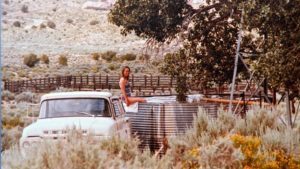 beneath an azure sky. Four months later, such fierce heat pulsed off the sand that I fully expected it to melt the rubber soles of my sandals. Late each afternoon I would thread my way down through juniper trees and gray granite boulders to a six-foot tall stock water storage tank, ferret out the little stepladder I kept in the grove of rabbit brush beside the windmill, take a few deep breaths to still my nerves, and…. Call it shock, or call it pleasure, I have never felt either so vividly as during those hot afternoon swims in icy water pumped from deep under the desert.
beneath an azure sky. Four months later, such fierce heat pulsed off the sand that I fully expected it to melt the rubber soles of my sandals. Late each afternoon I would thread my way down through juniper trees and gray granite boulders to a six-foot tall stock water storage tank, ferret out the little stepladder I kept in the grove of rabbit brush beside the windmill, take a few deep breaths to still my nerves, and…. Call it shock, or call it pleasure, I have never felt either so vividly as during those hot afternoon swims in icy water pumped from deep under the desert.
Like a rare and extended dream, those three Mojave years cast core, subconscious knowledge from my childhood into high relief. The same two archetypal poles—expansive vistas and cold, pure, luxuriant water lifted from underground by a windmill—defined life on the western plains. I hadn’t returned to my literal home, where more and more of the prairies gave way to the plow each year, but to the spiritual home those prairies had inspired in my imagination—even more arid lands that, unlike the prairies, were too rugged to farm.
Seeing myself in the Mojave’s mirror, relishing its beauty and the blessed relief of its rare waters, I realized that although I’d left home at eighteen to live in the city, home had never left me. I was no less an outgrowth of western Kansas than a blade of buffalo grass or clump of sun-worshipping yucca. What differentiated me was the ability to realize the profundity of this earth-body connection, and to honor it by speaking up for the preservation of the water under the land of my birth.
December 28, 2017
Our Turn at this Earth: Descartes’ Legacy
“Our Turn at this Earth” airs every Thursday at 6:44 pm CT on KANZ (High Plains Public Radio).
http://www.julenebair.com/wp-content/uploads/2018/01/05541_regional_Descartes-Legacy-airs-122817.mp3
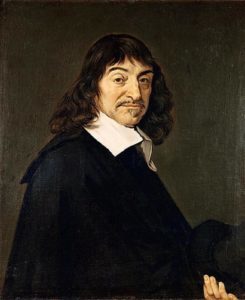 In my late twenties, I became enchanted by the mountainous deserts of the West. Whenever I could get a little time off from my work as bookkeeper for a San Francisco accounting firm, I would load up my old Toyota Land Cruiser with food, tools, and a few clothes, fill the jerry cans I’d mounted on the Cruiser with gas and water, and head for a place that looked intriguing on the many U.S. Geological Survey topo maps I’d collected.
In my late twenties, I became enchanted by the mountainous deserts of the West. Whenever I could get a little time off from my work as bookkeeper for a San Francisco accounting firm, I would load up my old Toyota Land Cruiser with food, tools, and a few clothes, fill the jerry cans I’d mounted on the Cruiser with gas and water, and head for a place that looked intriguing on the many U.S. Geological Survey topo maps I’d collected.
Usually I chose destinations marked with little tadpole-shaped squiggles on the maps. These indicated springs, where water flowed to the surface from some hidden source. The jeep trails were often so steep that I could see only sky over the Cruiser’s hood as I climbed them. But the reward for taking such treacherous roads, through hundred degree heat without an air conditioner, were these miraculous glens of trees, sedges, rushes, wildflowers, butterflies, and birds. Sitting in a cool, bath-sized pool I would look down at the valley I’d come from—as broad as San Francisco Bay with no dwelling or other human in sight. Bodily sensation allowed me to forget my struggles back in the city where, newly single, I spent many solitary evenings longing for companionship. Drying off in warm sun, my skin sensitized and my senses tuned, I felt united in body and mind, at peace within and without. A child of the semi-arid plains, my spirit was re-rooting itself in environs perfectly suited to its needs.
We westerners, by which I mean all of us whose cultural roots go back to Europe, inherited a way of thinking that divorces the body from the mind. To put it mildly, this has been unfortunate for the places we inhabit. The French philosopher René Descartes, of “I think, therefore I am” fame, helped shape the scientific method, which has greatly expanded our knowledge of the physical world, but Descartes also planted within us the harmful notion that our minds and bodies are separate and that, of the two, our minds are by far superior. His view of the body as mere matter extended to the entire realm of the physical. Western minds ever since have taken this as license to reign over nature.
In my childhood, I led an embodied existence, close to the earth, but as I grew older I became a product of my culture and let my mind take over. When, as a young adult, I rediscovered the joys to be had in the lap of nature, those joys reinforced and brought into indelible consciousness what I already knew in my bones. It was not “I think therefore I am.” It was I see, taste, touch, smell and hear, therefore the world is, and it is good. Let Descartes wander forever in the labyrinthine tunnels of his own thoughts. I want to live in this world, and I want it to remain intact. Our desire to conquer and subdue nature threatens our own existence as living creatures, as flesh and blood.
December 21, 2017
Our Turn at this Earth: Primal Bonds
“Our Turn at this Earth” airs every Thursday at 6:44 pm CT on KANZ (High Plains Public Radio).
http://www.julenebair.com/wp-content/uploads/2017/12/05541_regional_Primal-bonds-airs-122117.mp3
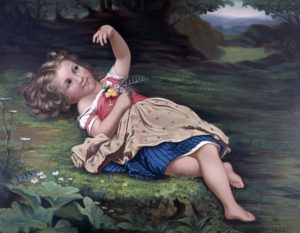 As a child on my family’s Kansas farm, I often whiled away entire mornings stalking a mother cat until she led me to her hidden litter of newborn kittens, or burrowing into my mother’s lilac bushes in pursuit of a baby cottontail. Of an afternoon, I might circle the pasture rattling a grain bucket until, in utter triumph, I managed to slip a rope around one of my horse’s necks, or I would sit in a low place in the farmyard where, after a recent rain, the earth had dried and shrunk into a jigsaw puzzle of thin, cracked clay. I would remove the pieces and drag my fingers through the smooth silt beneath. On spring evenings, I would stand at the yard fence, breathing the sweet scent of green wheat and watching stars blink on one by one.
As a child on my family’s Kansas farm, I often whiled away entire mornings stalking a mother cat until she led me to her hidden litter of newborn kittens, or burrowing into my mother’s lilac bushes in pursuit of a baby cottontail. Of an afternoon, I might circle the pasture rattling a grain bucket until, in utter triumph, I managed to slip a rope around one of my horse’s necks, or I would sit in a low place in the farmyard where, after a recent rain, the earth had dried and shrunk into a jigsaw puzzle of thin, cracked clay. I would remove the pieces and drag my fingers through the smooth silt beneath. On spring evenings, I would stand at the yard fence, breathing the sweet scent of green wheat and watching stars blink on one by one.
Just as my father had predicted, when I hit my teen years, I went from chasing horses to chasing boys. Shortly after I graduated from high school, one of those boys asked me to marry him. We took off for San Francisco without a backward glance. It probably doesn’t surprise you to learn that, eight years later, the boy and I were divorced. It may surprise you, however, to learn that the only cure I could find for the loneliness that set in after the divorce was to leave the city and go camping in the Mojave Desert.
There I could be outside again, surrounded by immensity, but also held in the physical embrace of the earth itself. I dragged my toes through warm sand, immersed myself in whatever clear water I could find (whether in a stock tank or mountain spring), rolled down dune faces, and took deep grateful breaths of sage-scented air. For the first time since childhood, nature ignited my curiosity and fired my drive. Only now the field of exploration was much larger than the quarter mile radius around my family’s farmstead knoll. What, I wondered, lay beyond that mountain?
After following a jeep trail for hours across ravines and over rocky summits, discovering water trickling out from a granite wall to form a pool among marsh grasses excited me as much as finding a litter of tawny kittens hidden among grain bags in a musty barn loft had excited me as a child. The sight of soft pink sand dunes at dusk aroused as much tenderness in me as when I was a child holding a trembling bunny in my trembling hands. In this way I rediscovered the joys and sorrows of physical experience outdoors. It was good to be in my body again. I’d been living in my head for far too long.
In my lucky farm childhood I didn’t play with plastic toys or watch that much TV. Instead I had many primal, unfiltered experiences with the elemental things of the earth—dirt, stars, grass, fur. I’ve described those experiences here because, since then, on the plains, as in so many other places, the earth has suffered at the hands of humans. How can we not feel, in our own flesh, the damage done to the places we bonded with physically, as children? It is through sensory experience in childhood that our most fierce loyalties are formed.
December 17, 2017
Our Turn at this Earth: The Beauty of Dry Places
“Our Turn at this Earth” airs every Thursday at 6:44 pm CT on KANZ (High Plains Public Radio).
http://www.julenebair.com/wp-content/uploads/2017/12/05541_regional_The-beauty-of-dry-places-airs-121417-1.mp3
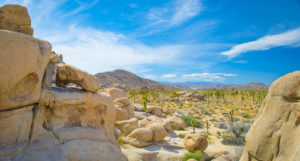 As Plains farmers, my parents had to stay focused on very practical concerns. Our livelihood depended on carefully preparing the soil, then planting, nurturing and harvesting crops. But the impractical whims of the sky often interfered with my parents’ practical efforts. My ancestors had chosen a marginal and often ruthless climate in which to ply their weather-dependent trade.
As Plains farmers, my parents had to stay focused on very practical concerns. Our livelihood depended on carefully preparing the soil, then planting, nurturing and harvesting crops. But the impractical whims of the sky often interfered with my parents’ practical efforts. My ancestors had chosen a marginal and often ruthless climate in which to ply their weather-dependent trade.
I spent many summer evenings standing on the balcony of our big old farmhouse with my father, scanning the western sky for signs of advancing rain. I loved rain as much as he did—because of the spring it put in his step, and because of the life it never failed to awaken in my mother’s flower garden. But even as I inhaled the delicious scent of wet earth after a summer rain, I also gloried in the return of sunlight to the treeless and often cloudless expanse that surrounded our farmstead.
This was the paradox of farming in a semi-arid region. We almost always wanted and needed more rain, but the place’s beauty depended on receiving not too much of it. More rain, and trees would have obscured the circular horizon, putting us ill at ease, for a plainsperson who cannot see far is never content. More rain, and the grass would not have been pale green, emanating serenity, but too vivid for eyes trained on pastels.
I discovered to my dismay after leaving Kansas as a young woman that skies in moister climates lack the ethereal, pale blue transparency that so perfectly complemented the buffalo grass prairies of my youth. While I found San Francisco and the seashores to the north and south of it beautiful, the weeklong winter storms seemed to me to last forty days and forty nights. Only when I began venturing into the California deserts did my plains-bred sensibilities reawaken.
Jagged Mojave Desert mountains were not grassy plains, but they surrounded valleys as broad as the Kansas county where I was raised. As I explored the mountains’ cactus-strewn crags, I recalled the Arickaree Breaks, the wild lands that had begun just a few miles north of our farm in the northwest corner of Kansas where I grew up. Once again I could follow the flights of kestrels and red-tail hawks above the curves of sandy creek beds.
And once again I smelled the magic that rain brought to dry earth, this time mixed with the intoxicating scent of damp sage. Best of all, from the impractical point of view of this farmer’s daughter, the place was too dry to be farmed. For this reason, the variegated plant life remained intact. I could see for miles again, but over land bearing few if any scars.
Standing on Mojave Desert mountainsides above vast plains, I felt as if I were looking out from the center of my true self. Sometimes we must leave home to find ourselves. In my case, I discovered that the self I’d been in search of all those years had been created by the place I left.
December 11, 2017
Our Turn at this Earth: Wild Times
“Our Turn at this Earth” airs every Thursday at 6:44 pm CT on KANZ (High Plains Public Radio).”
http://www.julenebair.com/wp-content/uploads/2017/12/05541_regional_Wild-times-airs-120717.mp3
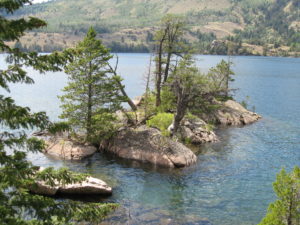 May, 1968. I’m eighteen, too young to know what love is. This guy comes to my small western Kansas town driving a classic1956 T-Bird. I decide to attend college in eastern Kansas rather than in Colorado as I’d planned, because that’s where the guy lives. By October he proposes, and in January we are wed. I drop out of school and off we go to San Francisco, where he has found a job as an audio engineer.
May, 1968. I’m eighteen, too young to know what love is. This guy comes to my small western Kansas town driving a classic1956 T-Bird. I decide to attend college in eastern Kansas rather than in Colorado as I’d planned, because that’s where the guy lives. By October he proposes, and in January we are wed. I drop out of school and off we go to San Francisco, where he has found a job as an audio engineer.
I remember driving across Utah with the radio blasting “When You Come to San Francisco, wear flowers in your hair.” I didn’t have flowers, but I had high hopes, which were not disappointed as we wound down the west side of the Sierra Nevada Mountains. The grass was greener, in January, than I’d ever seen it, even in May. I thought I’d arrived in paradise.
Wild times ensued, or so you might think. But the late sixties in San Francisco were not all they were cracked up to be, at least not for this Kansas-bred girl. I had little in common with the man I’d married before I was old enough to drink our wedding champagne. It took eight long years before I got the courage to leave him. I then dove into truly wild times. I mean “wild” literally. I mean “dove” literally too.
I went on a backpacking trip to the Sierra Nevada Mountains. Still a flatlander at heart, I resented the long climb through August heat, until we reached the shores of a lake filled with glacier melt as clear as the mountain air. Lying face down on a boulder with the high altitude sun hot on my skin, I began a long flirtation with the icy water, first dragging a hand through it, then a toe, until at last I had no choice but to dive in. My scream echoed off the surrounding cliffs. But once my body adapted to the cold, I couldn’t get enough of the water’s silken feel on my skin.
It was August, 1976. I was twenty-six, old enough, at last, to know what love was, and this was it. So began one of the most passionate relationships of my life. On this blue planet, I’d grown up in one of the pale-green places, where surface water was not a given. It wasn’t a given in the Sierras either, but a pleasure I had to climb to reach. Swimming in cold, clear lakes became my “thing.” I loved watching webs of refracted sunlight undulate over my arms and the sparkling rocks below me. And I loved the way my skin felt when I got out, every cell tingling and alive.
A dozen years after that first dive into a mountain lake, I went back home and discovered that the irrigated crops being raised on our and our neighbors’ farms were draining the Ogallala Aquifer, the primary and, in most places, only available water under the Great Plains. Because of the intimate relationship I now had with water, this didn’t just seem impractical—how would communities sustain themselves in the future on dewatered plains?—but like the travesty it was.
December 4, 2017
Our Turn at this Earth: Leaving Goodland
http://www.julenebair.com/wp-content/uploads/2017/12/05541_regional_Leaving-Goodland-airs-113017.mp3
My Kansas hometown was straightforwardly named for what surrounded it: good land. I grew up on some of that good, if somewhat hillier than 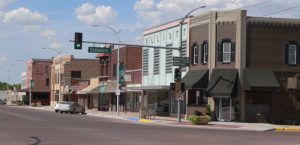 prime, land, about fifteen miles beyond town as the crow flew, through sunny skies over sunlit plains, up toward the Colorado and Nebraska borders.
prime, land, about fifteen miles beyond town as the crow flew, through sunny skies over sunlit plains, up toward the Colorado and Nebraska borders.
My father always assumed that one, if not both, of his two boys would eventually become farmers like him. They’d been trained in the occupation, driving endless tractor rounds throughout their teen years. They considered this pure drudgery. I, on the other hand, thought it would be fun to drive tractors. But in those days only boys became farmers. My father hoped that I would do the next best thing, and marry a farmer.
He encouraged me to get a teaching or nursing degree, just to “fall back on,” as he said, since he assumed that my husband would be the provider. I had no interest in these occupations, the only ones he considered suitable for a girl. When I was eight, the Russians had fired the first volley in what had become a fervent space race. At night on the farm, we would watch their satellite, Sputnik, track across the sky, threatening to colonize the galaxy before we’d even gotten off the ground. In that climate of national paranoia, I vowed to become a nuclear physicist, the most prestigious “male” occupation I could imagine.
By the time I graduated from high school, though, with many of my male classmates heading off to fight in Vietnam, I had lost interest in winning the Cold War. I wanted to help end all war. Perhaps I would become a diplomat. Or maybe I’d be a journalist.
While I resented the limitations my father put on my abilities and worth, I failed to question the most limiting perception of all—that a girl’s main goal in life was to find a good husband. To heck with the space race. The only race I’d ever been in, as it turned out, had been the race to find a husband. When, during my second semester in college, a city boy proposed, I felt like I’d reached the finish line without even having to complete the first lap. His parents were wealthy, meaning I would never have to worry about making my own way in life, or so I thought.
So much for my father’s well-laid plans. To his bafflement, he watched each of his kids, in turn, reject the life he’d imagined for us. It is a story as old as the hills, or in our case, as old as the plains. Livelier places, greater prestige, and greater ease to be had elsewhere prove irresistible to farm kids and kids from small rural towns. But could part of this problem derive from attitudes embedded in rural culture itself?
When I was sixteen, my father traded that good land I’d grown up on for some other even better land and built a new house in town. When I asked him why he hadn’t built on the new farm, he said it wouldn’t have been fair to ask my mother to make that sacrifice. When had farm life become a sacrifice in our minds, and not a privilege?
December 3, 2017
Our Turn at this Earth: The Slow Migration
http://www.julenebair.com/wp-content/uploads/2017/12/05541_regional_Slow-Migration-airs-112317.mp3
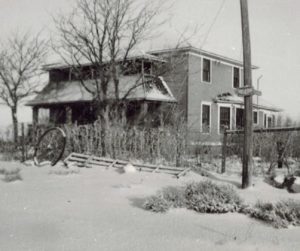 They Came to Stay—that is the title of three big history volumes recording the stories of the first settlers of Sherman County, Kansas. I grew up basking in the pride of that phrase. Proof of my own family’s long past in Sherman County could be seen in the crumbled remains of the sod house where my mother’s older siblings had been born. In 1919 my grandfather built the big, broad, two-story farmhouse we lived in. Clearly, he believed that his family would stay on that land for generations to come. Why else go to all that effort?
They Came to Stay—that is the title of three big history volumes recording the stories of the first settlers of Sherman County, Kansas. I grew up basking in the pride of that phrase. Proof of my own family’s long past in Sherman County could be seen in the crumbled remains of the sod house where my mother’s older siblings had been born. In 1919 my grandfather built the big, broad, two-story farmhouse we lived in. Clearly, he believed that his family would stay on that land for generations to come. Why else go to all that effort?
Yet when I was sixteen my parents announced they’d traded our farm for land elsewhere in the county and that they would be building a new house in town. I couldn’t have been more thrilled. Forget the horse who had been my first love since grade school. Forget our dozen yard cats and all three dogs, and the chickens, ducks, rabbits, pigs and cows. Forget my father’s thousand ewes. No longer would I stand watch with him on the farmhouse balcony, hoping that clouds gathering in the west would roll toward us and bring rain. No longer would grand wheat fields and pale green buffalo grass pastures stretch before me each time I looked out my bedroom window or stepped out the door. I didn’t care. I’d always envied my town friends who got to hang out with one another after school. Now I would be a town girl too.
Only years later would I begin to understand how disorienting that move to town had been. Far back into my family’s European past, all my ancestors had ever done was farm. If anyone asked, we would have said we still farmed, but really only Dad did. Each morning, he would gather his iced tea jug and lunch pail and head out to the new farm while the rest of us went about our town lives.
None of us ever remarked on what a sudden and severe change we’d undergone or seemed worried that, in leaving the farm behind, we’d also left ourselves. Today I look upon that move to town as the first step in a progression that made it possible, four decades later, after my father had died, for us to entertain, then act on, a thought that had once been unthinkable.
A few years after the sale, a neighbor farmer, having watched so many families like ours disappear, shook his head in bewilderment. “It was all nothing but a slow migration,” he said.
“I know,” I said. “I thought we came to stay.”
We had that conversation at my mother’s funeral in the church she’d attended her entire life.
Economic or social forces generally drive migrations. The food supply diminishes or a neighboring tribe or nation invades. What forces were at work that caused many High Plains families like mine to abandon our way of life? What do you think? Please write to me in care of this station or at my Web site and share your ideas.
Our Turn at This Earth: Plains Icons
http://www.julenebair.com/wp-content/uploads/2017/12/05541_regional_Plains-icons-airs-111617.mp3
Every few years, I obey the compulsion, as instinctive as a migratory bird’s, to return to the home nest. Last time I visited the northwest Kansas farm I 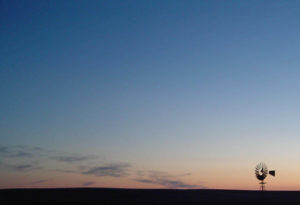 grew up on, I parked my car by the pole that used to bring electricity to our house. The electricity it brought now kept a pivot sprinkler clocking through the ghost of the farmstead my mother’s family had settled in 1906. As usual, I walked down the rows of ankle-high corn, searching for artifacts I might recognize. Once I found a piece of the bowl my mother used to mix cakes in and a piece of blue glass from a vase in which she placed flowers from her garden.
grew up on, I parked my car by the pole that used to bring electricity to our house. The electricity it brought now kept a pivot sprinkler clocking through the ghost of the farmstead my mother’s family had settled in 1906. As usual, I walked down the rows of ankle-high corn, searching for artifacts I might recognize. Once I found a piece of the bowl my mother used to mix cakes in and a piece of blue glass from a vase in which she placed flowers from her garden.
But on this visit I discovered an even more telling artifact. In a clump of tall weeds near the pit silo where we used to burn our trash and throw our junk, I happened on the head of our old windmill. Almost every Plains home has at least one sculpture of a windmill woven from wheat or a painting of a windmill silhouetted by a spectacular sunset—to the point that these Plains icons have become Plains clichés. Yet it’s only fitting that we memorialize them.
Walter Prescott Webb, author of the first comprehensive history of the Great Plains, wrote that windmills were “…to the drought-stricken people like floating spars to the survivors of a wrecked ship.” He pointed out that, in order to survive, early settlers—most of whom came from moister climates in Europe or states to the east—had to adapt to the dry and treeless place. Lacking wood, they learned to build with sod. Tormented by the wind at first, they soon came to recognize it as a resource offering them the means to pump groundwater.
The windmill whose remains I now stood beside had creaked and clanged all throughout my childhood. Over the course of an afternoon, its shadow would progress across the farmyard and up the front of our big barn. How strange it felt to tower over what had once towered over me. Not only strange, but unsettling: Today, there were no creaks and clangs, only the pulsating, distant roar of the big truck engine that pumped water for the pivot sprinkler. The windmill had pumped at the rate of about five gallons a minute. The irrigation engine was probably drawing about 800 gallons in that same wink of time.
I never knew my maternal grandfather, but his frugal values and acceptance of plains realities were passed down to me nonetheless. My mother often told me that whenever she filled the tin cup that hung from the windmill, he made her drink it all. “Water is precious,” she recalled him saying. “You don’t just pour it on the ground.” If he had lived long enough to witness water gushing from the earth onto his fields, what would he have thought? Would he have imagined endless bounty or eventual ruin? Would he have foreseen green crops all the way to the horizon, or would he have seen red?
December 1, 2017
Our Turn at this Earth: Introduction
“Our Turn at this Earth” airs every Thursday evening
at 6:44 pm CT on KANZ (High Plains Public Radio).
http://www.julenebair.com/wp-content/uploads/2017/12/05541_regional_our-turn-at-this-earth-intro-airs-110917-2.mp3
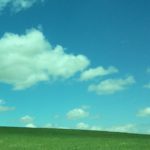 “I grew up on the mild-green, short-tufted buffalo grass prairies of northwestern Kansas.” That is the first sentence in my first book, One Degree West. Not all people define themselves by their childhood past, but still today, if asked to explain who I am, I would begin there—on that western Kansas farm, under a broad sky on the dry sunlit plains, in a family who never had to question who we were, because we were directly connected to the source of our identity. Today, all that is left to prove my family once existed in that place are bits of broken china scattered over the ground in a circle of irrigated corn. Yet it never ceases to amaze me that I’m as closely identified with that farm as if we’d never left it.
“I grew up on the mild-green, short-tufted buffalo grass prairies of northwestern Kansas.” That is the first sentence in my first book, One Degree West. Not all people define themselves by their childhood past, but still today, if asked to explain who I am, I would begin there—on that western Kansas farm, under a broad sky on the dry sunlit plains, in a family who never had to question who we were, because we were directly connected to the source of our identity. Today, all that is left to prove my family once existed in that place are bits of broken china scattered over the ground in a circle of irrigated corn. Yet it never ceases to amaze me that I’m as closely identified with that farm as if we’d never left it.
There are, of course, many other things I could say about myself. I’m a writer. I love swimming in cold, clear wilderness lakes. I love camping in remote, rugged western places. I’m a mother and grandmother. Nothing relaxes me more than digging in my garden. But all of these things about me derive from that Kansas past. When I write, I write about the High Plains. Water draws me to it because I grew up in that dry place, where the water our lives depended on lay deep underground, unseen. The wilderness draws me because we had enough pastureland for me to imagine the prairie rolling as it once did, untilled all the way to the circular horizon. I parent and grandparent much the way my parents did, according to the values I learned from growing up in that grandly beautiful but also harsh and demanding place. I garden because my parents did and because, psychically, I’m still rooted in the soil of home I visualize my family having sprouted out of that soil like the giant locust tree whose seed pods I used to reach over our house’s second story balcony rail to pluck. My parents, older brothers and I were one with the place.
The title for this series, “Our Turn at this Earth,” comes from Pearl S. Buck’s classic, The Good Earth, about another farm family, in pre-World War I China. As subject to folly as humans anywhere, they focused on the fulfillment of their desires and on storing up financial wealth rather than on the true source of meaning in their lives—the land that gave them a livelihood and the water that gave them life. “Some time, in some age,” Buck wrote, “bodies of men and women had been buried there, houses had stood there, had fallen, and gone back into the earth. So would also their house, some time, return into the earth, their bodies also. Each had his turn at this earth.” I will be talking in this series about how the earth shaped my family, how we shaped it, and about the moral struggles that all plainspeople face during their turn at this earth.
February 26, 2015
We Intended to Stay
The romance and heartbreak implied in the title of The Ogallala Road transcend the realm of interpersonal drama. Instead, Bair weaves a number of her personal romances together into a sort of tapestry that centers around her love of water. Raised by farmers in western Kansas, Bair is born and bred on water from the underlying Ogallala aquifer, the largest underground source in the United States. Water has always seemed an abundant thing, sparkling as it spouts from her family’s wind-powered pump and appearing in “magical” streams and pools around their farm property. But after spending some time living in the Mojave desert, where she has to haul her cooking and drinking water from a source 2 miles away from her home, Bair develops a deep appreciation for water as something deserving of reverence and protection. She moves back to Kansas with a new baby in tow and finds that over the course of her life, her family’s dryland wheat farm has become more and more dependent upon pump irrigation, chemical pesticides and herbicides, massive machinery, and government subsidies. Bair leaves Kansas again to pursue her career in writing, but is eventually drawn back by responsibility to her family, a love of the land, and a new romantic interest. Her family must make a series of difficult decisions about the farm, and as Bair struggles to redefine her identity in the world of modern farming, she is drawn to studying the Ogallala. The story is introspective, romantic, historical, and political, also offering a narrative about self-discovery through a connection with nature. I recently spoke with Bair, and we discussed some of the ideas brought up in her book: our interdependence with nature, environmentalism on the Great Plains, and the definition of home in our quickly changing world.
IA: What was your original inspiration for writing this memoir?
JB: Guilt over the aquifer was my original inspiration. At first, it was very difficult to figure out how I was going to interweave all of these threads. I knew I needed to tell a personal story, and I think over time there was no real division between my story and the story of the water. It was all very integrated for me. That water made it possible for us to live there; it gave us a life in that place; it gave us an income, eventually. Meanwhile I had become this water nut, living out in the Mojave desert, going swimming in a stock tank. I love nothing more than diving into a cold lake on a hot summer day, so I think there’s a sort of allegiance there to water. It’s all very personal to me.
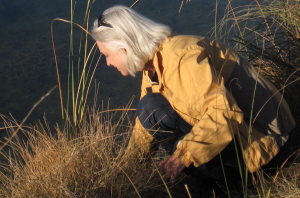
Testing the Waters of the Ogallala-fed Republican River, October 2013.
IA: It comes across in the book that you have somewhat enlightening experiences when you are interacting with water in its pure form. Can you elaborate?
JB: Well, I find it beautiful to look at, first of all. I find it inviting, irresistible. Once you dive into a large body of clear, icy water you discover how exhilarating it is. The body adapts relatively quickly, and you fall into a sort of ecstatic state. And, when you get out of the water, your skin just tingles, and you feel alive in a way you’ve never felt before. All of the troubles you’ve had have been driven out of your mind by the shock, basically. Endorphins kick in. It puts you in a heightened state.
IA: The difference with a thing like an aquifer, though, is that you can’t dive into it. It is hidden; it’s not a visually beautiful thing you can identify or dive into. How did your obsession with the Ogallala begin?
JB: The obsession began when I was back in Kansas in my mid-30s and working with my father; this would have been the 1980s, and we were flood irrigating then. I had been living in the Mojave desert prior to that. When I was living in the Mojave, I had become super appreciative of water because I had to haul my own water from a neighbor’s windmill supply and make it last a long time. Back in Kansas, just seeing all of that water coming out of the ground in our semi-arid climate in western Kansas and hearing those irrigation engines running all day long, each of them pumping anywhere from 600–1,000 gallons a minute. I started doing the water reports and realized that we were pumping on average 200 million gallons of water each year, which troubled my conscience. I had developed an environmental ethic while living in the desert; I was surrounded by wilderness—and I liked the idea of preserving the beauty and the resources that we have. I knew that we were wasting the one resource that had made life there possible since Paleolithic times for humans, and for millions of years before that for nonhumans.
IA: Do you think that the hidden nature of aquifers makes them more vulnerable to abuse?
JB: Absolutely. Also, the Ogallala falls in that western part of the central states where environmentalism is not an ethic that is very widely shared. There’s also a sparse population where there are fewer people to care about it. So farmers have been given free reign over the water for a long time, and though they may not have free reign now, they are still allowed way more water than can be legitimized, and they are primarily using it on crops, like corn, soybeans, alfalfa, and cotton. None of these crops belong in that region. They do not do well as dryland crops, but they do grow well elsewhere without the aid of irrigation. If we’re talking about water efficiency, it doesn’t make much sense to spend the nation’s largest aquifer on crops that cannot be naturally sustained in that region.
IA: Isn’t it also a system that has always required government aid to make it viable, either by enticing homesteaders out to turn wild buffalo grasslands into farms, and then enacting subsidies to turn dryland farms into irrigated corn factories?
JB: The historian Prescott Webb defined dryland agriculture as the science of farming where rainfall is deficient. When I was growing up in the 1950s we had become proficient at that. We had experienced the dust bowl as a major setback in the 1930s, due partially to the sort of farming practices we had used, and so different methods were adapted. But by the time I was born, we were good at dryland farming, and we were prosperous. And, many of our neighbors were prosperous. It is a myth that you need Ogallala water for agriculture to survive on the Great Plains. We were surviving quite well, and since then many more drought-tolerant plants have been developed. There’s just one problem: We now have climate change, so the droughts are probably going to last longer, and the heat will be more severe, causing even more evaporation. So crops that grew there traditionally without the aid of irrigation will now need some help.
That is what the United Nation’s International Panel on Climate Change is telling us. Their latest report is telling us that we need to preserve our aquifers, because they offer some of the few ways that we can offset the impacts of climate change. When we challenge farmers to change their practices, they often say that they need to feed the world, but it seems tragically inefficient for us to feed the world by processing corn through livestock. Most of the corn grown in this region goes to feeding livestock, cattle primarily. Much of the land in the plains are grasslands that are so marginal that they often should not be farmed in the first place, but this land is perfect for bovines. Bovines are the ones that evolved on this land, the buffalo, and so it makes no sense to use all of this water to grow corn to feed cows. And then, another 40% of the corn being grown is going to the production of ethanol. You can’t say that you’re feeding the world if that’s where your crop is going. And there are very few scientists these days that will defend the use of biofuel, as it requires just about as much fossil fuel, gallon for gallon, as it does to produce ethanol. So none of this seems like a very efficient way to spend our water.
IA: It is odd to me that people from the rural countryside of America, people who live their lives intimately connected to nature are less likely to identify as environmentalists than people who live in dense urban areas.
JB: It is strange, isn’t it? I suppose when you grow up in the Plains you have a family history of a difficult existence. Your grandparents broke that land with horses and plows, and so any new machine—anything that makes the work less labor intensive—is considered progress. And I think we also inherited our grandparents’ notion that the world is limitless; I mean, the place looks limitless when you’re out there: the idea that the grass goes on forever, the water goes on forever, and we are so small and insignificant that it would be impossible to destroy it.
But of course, everyone is realizing now that is not the case. I think there is a lot of despair out there because of what is happening, what is changing. It is not as beautiful as it once was, and there is certainly a lot of despair over what is happening to the water. Everyone knows that the water won’t last forever, and that measures need to be taken to protect it. What is going to happen to the poor farmers when the aquifer is gone? A whole ecosystem is being destroyed. Farmers everywhere will tell you how they used to skate, fish, or swim in the surface water, and they just can’t do it anymore.
IA: You do, at one point in the book, interview some organic farmers in the Plains. Do you see evidence of a developing environmental ethic in the area?
JB: I think it is developing. I think the facts are forcing consciousness to develop about the drawdown of the aquifer, the fear. There are more organic farmers appearing, one of whom I interview in the book. He claimed not to have a strong philosophy driving his decision to go organic, but that he realized there was a greater price premium on organic crops. I do think perhaps he may have had more of a philosophy than he was willing to let on, but it can be tough discussing these ideas out there.
IA: Part of your development of your environmental ethic stemmed from leaving your home and from gaining perspective through travel, through cutting your ties from tradition and farming. Through leaving you learned to love the land, but you also lost the privilege of learning how to run a farm and being able to pass down that knowledge and that love for that place to your children. This is one of the great tensions in the book: how does one define home? The same trajectory of technological advancement that changed the farm and is destroying the aquifer also allowed you the choice to leave the farm and go to school—to develop a different perspective than that you were raised with.
JB: A major theme in the book is home. On the one hand, a lot of us built these big houses—these big two-story houses with nice refinements, beveled and leaded glass, nice woodwork, and bay windows. Every building on the farmstead was large, and if you looked at this from an aerial view, you would see that whoever had built these houses intended to stay there. And I know that my father wanted me and my brothers to stay in that area and marry farm people, becoming farmers ourselves. But we were getting a mixed message, too, because our father wanted us to do well in school, and though he believed that being a farmer was the only way of life, he also wanted his sons to become doctors. And I mention this in the book, but it’s very different from the Hopi [an indigenous, agricultural tribe centered in Arizona, southern Utah, and Colorado], because what they tend to value very consciously in their culture is staying in place, staying rooted in the place where they have been for 600 years, and maintaining the life forms around them and the life-giving substances—the soil, the water—so they could continue living there for thousands of years. We just didn’t have that environmental ethic, or a spiritual belief that we were synonymous with our land. We didn’t feel that, which made it possible for us to move despite the fact that we had built these giant houses.
IA: You tell a story in the book about a Hopi myth that states that there have been three different cycles of humans, each of which killed themselves off by overstepping ecological limits.
JB: Yes, and what I love about this is how they feel a sense of gratitude for living in the desert because the aridity does not allow them to overstep their limits. They cannot forget and mess up again. They can see this so clearly. They still have the same sort of struggles we have, young people who would rather move away, live elsewhere, and leave the culture, but the fundamental ethic there is to accept what is, which I think is probably the fundamental spiritual ethic that allows for peace in the world and the peaceful cohabitation with all of nature. We never accepted the High Plains; we wanted to change them, and that to me is too bad, because early settlers figured out techniques to live on this land. To reference that same historian, Prescott Webb, he discusses in his book, The Great Plains, how the first settlers adapted: There was no wood, so they built with sod. There was no water so they developed windmills to pump it. But I think they forgot to plan for the long haul. They were just trying to figure out how to live there for now. They weren’t thinking about a thousand years of descendants that would want to live there. They thought about the West as the land of possibility; well, we’ve taken that land, and we’ve mined away all the possibility.
IA: And undermined our own ability to stay there.
JB: And what we’re really doing is undermining our own identity as Americans when we do that.
Author’s Bio: Ivy Anderson writes on topics related to water.

